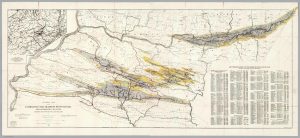Pennsylvania’s Anthracite Coal Region
There are a plethora of occupations that are dependent upon the formation of the land in a certain location. The development and design of a landscape has a lasting impact on the means of production and labor that create an effective economy. In central Pennsylvania, the anthracite coal mining region began in roughly 1792 with the founding of the Lehigh Coal Mine Company by Josiah White and Erskine Hazard. This was the first commercially operated coal mine. The anthracite region would see new mines developing throughout prominently six counties: Luzerne, Lackawanna, Carbon, Northumberland, Columbia, and Schuylkill. Thus geographically, there are northern, middle, and southern anthracite fields.
As anthracite mining began spreading rapidly throughout central Pennsylvania, many problems arose surrounding working conditions, town life, pay, etc. It was common for miners to have major and minor accidents within and outside of the mines. There were many perilous activities a miner had to perform.
The coal companies began hiring boys to work in the mines as early as ages six to eight. They would pick rock, slate, and refuse out of the coal in the breaker; an arduous and dangerous task for a young boy.[1] There were usually contract miners, laborers, foremen, and superintendents that worked per colliery. There was a large inequality of wages between laborers and miners that caused a further divide between ethnic enclaves. The Welsh immigrants who were skilled miners who usually became the foremen and superintendents of a colliery. While Irish immigrants were “distrusted” by the coal owners and other miners. This was partly because of the Molly Maguire movement, who were accused of murder, arson, and other crimes throughout the mining districts.
Nevertheless, the dangers and the perils of a coal miner were extreme. The mines could be very difficult to mine in without proper lightning, protection, ventilation, or other essential equipment. Usually due to poor ventilation, mine fires would trap miners in the coal mines and the only means of escape was the main shaft, which at times would be destroyed by flames.[2] Other mining accidents included accidents due to poor quality of the colliery with columns falling on people, and commonly floods, which would occur when a geological depression in the mine filled with water and created a flood in the mine.[3] If a miner did not die from an accident in the coal mine, it was common to die from “miner’s lung” or “black lung” from the sulfur toxins in the mines. In order to provide for their families and contribute to the economic prosperity of their town, miners would sacrifice their well-being and risk death.[4]
In order to preserve the heritage and culture of the coal mining industry, while paying homage to the coal miners and their families, some anthracite communities choose to represent coal miners through monuments. These representations are sometimes specific to a certain town’s coal history, however, many represent the greater Pennsylvania anthracite region.
By critiquing the two out-facing public mediums, newspapers and monuments, I will investigate how Pennsylvania anthracite coal communities choose to represent their coal heritage.
[1] Janet MacGaffey, Coal Dust on Your Feet: The Rise, Decline, and Restoration of an Anthracite Mining Town (Lewisburg, PA: Bucknell University Press, 2013), 23.
[2] Ibid., 25.
[3] Ibid., 25.
[4] The few descriptions of different types of accidents in the coal mines is not an exhaustive list. There were many other perils and dangers depending on the skill level of a miner or laborer and the quality of the colliery and its owners.

